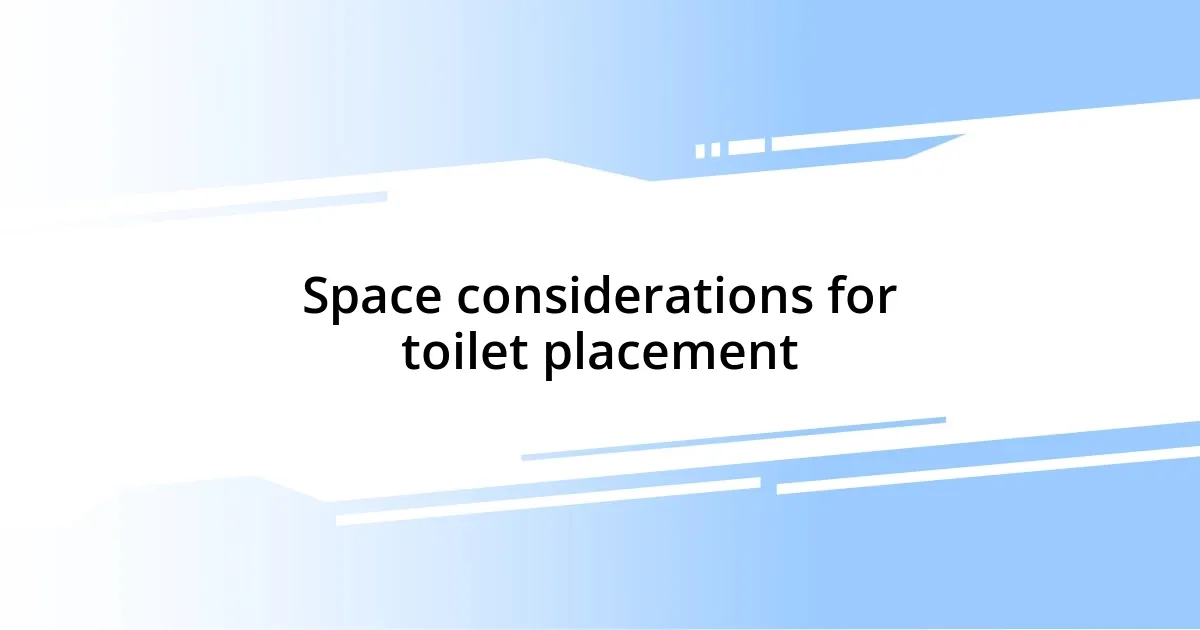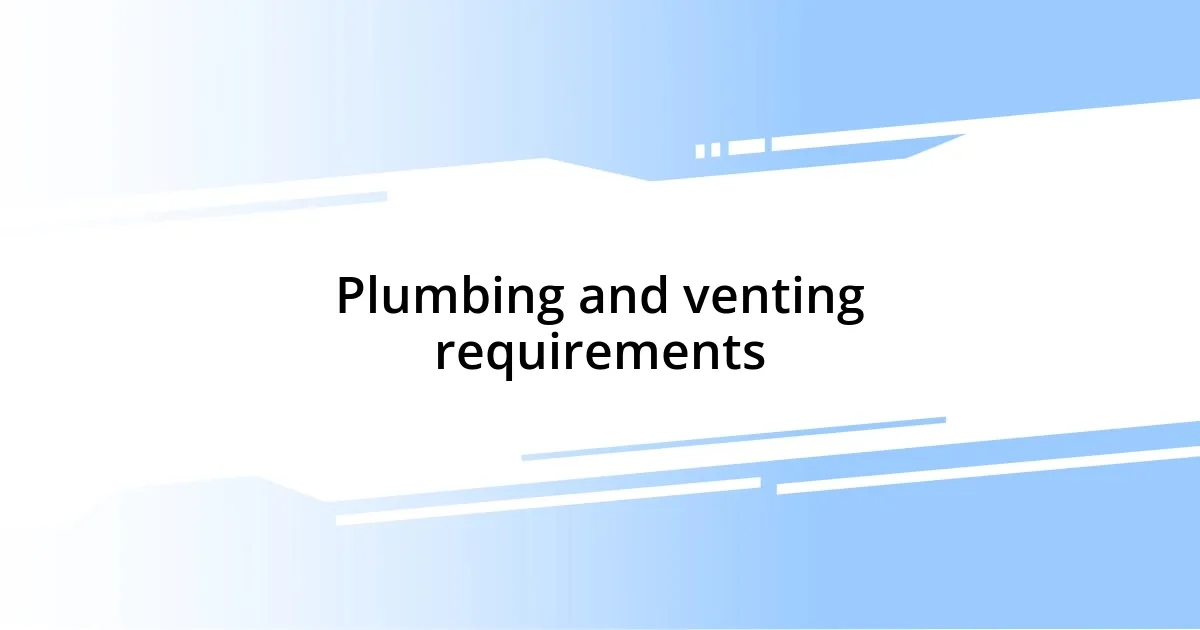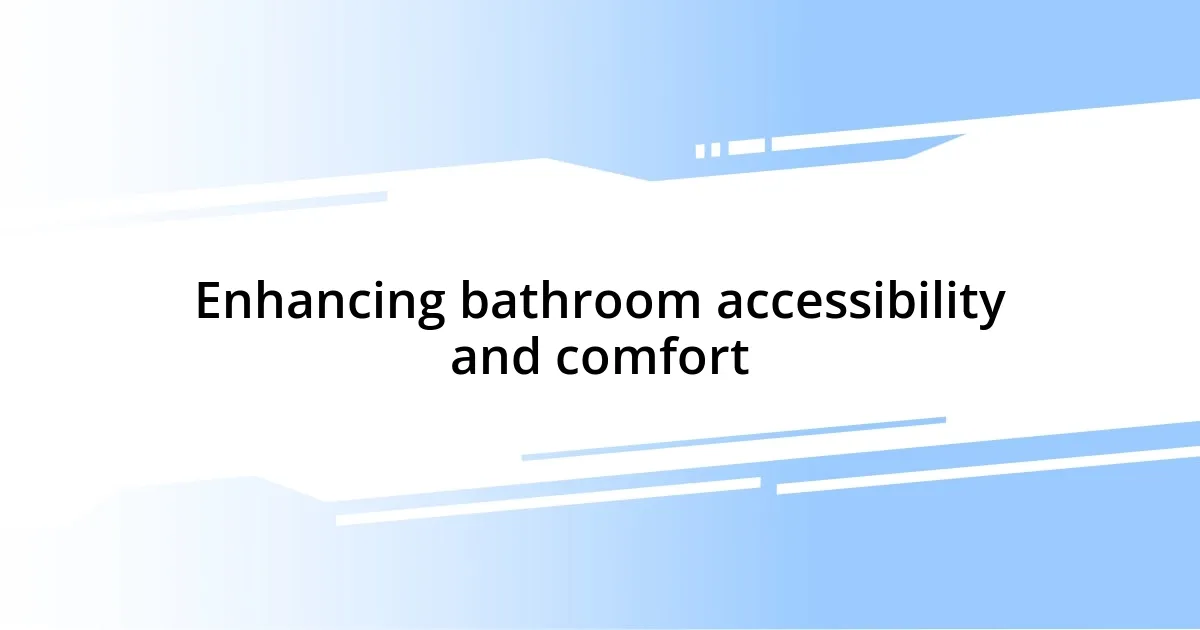Key takeaways:
- Toilet placement impacts daily routines, privacy, and overall comfort in the bathroom.
- Key factors for optimal placement include space, plumbing accessibility, ventilation, and user privacy.
- Common mistakes include poor spacing, lack of privacy, and neglecting proper plumbing and venting.
- Enhancing accessibility through thoughtful design and features like grab bars and adequate lighting improves user experience.

Understanding toilet placement importance
Toilet placement might seem like a trivial detail, but it can drastically impact our daily routines and overall comfort at home. I remember visiting a friend’s house where the toilet was awkwardly positioned right beside the door. It made me feel exposed and uncomfortable, almost like I was intruding on someone’s private space. Isn’t that something we all want to avoid?
Considering the flow of a bathroom is crucial as it affects not just the user’s experience but also the overall functionality of the space. For instance, I’ve found that placing a toilet too close to other fixtures, like a sink or shower, can lead to annoyances. Have you ever tried to clean in cramped quarters? It’s a hassle that I wouldn’t wish on anyone!
Then there’s also the matter of plumbing and accessibility. In my own home, I chose to place the toilet in a spot that not only made it easy to reach but also kept plumbing issues at bay. It’s all about finding that balance between aesthetics and practicality. Could the wrong placement lead to more than just aesthetic complaints? Absolutely! It’s an essential aspect that deserves thoughtful consideration.

Factors influencing toilet location
When it comes to determining toilet location, several factors come into play. One critical influence is the size and layout of the bathroom itself. I recall a time I helped a friend redesign their small bathroom, and we had to make some tough decisions about space. The toilet needed to fit without blocking pathways or making the area feel cramped. This experience underscored how vital it is to assess the room dimensions before making any permanent changes.
Consider these key factors that influence toilet placement:
- Space and Layout: Ensure adequate room for movement.
- Plumbing Accessibility: Align with existing plumbing to minimize costs.
- Ventilation: Position the toilet where proper airflow is available to prevent odors.
- Proximity to Fixtures: Maintain a comfortable distance from sinks and showers for ease of use.
- User Privacy: Situate the toilet away from high-traffic areas for added comfort and privacy.
Reflecting on each aspect can significantly enhance the functionality and comfort of a bathroom. I’ve noticed that whenever I streamline these considerations, the overall harmony of the space improves, making it more inviting for everyone.

Common toilet placement mistakes
One of the most common mistakes in toilet placement is neglecting privacy. I remember walking into a bathroom where the toilet was directly facing the entrance. It felt like a complete lack of consideration for the user’s comfort. Nobody wants to feel like they’re on display during a private moment, right? This oversight can create a very awkward atmosphere, leaving visitors feeling embarrassed rather than relaxed.
Another frequent error is cramming the toilet into a corner without much thought. In my previous apartment, the toilet was wedged so closely to the wall that I had to awkwardly twist to use it. Not only was it uncomfortable, but it made cleaning nearly impossible. I’ve learned that a few extra inches can make a world of difference in terms of accessibility and maintenance.
Lastly, poor spacing between the toilet and other fixtures can lead to frustrations down the line. I had a friend who installed their toilet way too close to the shower, and after just a few months, they were already regretting that choice. It’s essential to allow adequate room for easy movement and cleaning. I’ve seen how thoughtful placement can turn a potentially cramped space into one that flows beautifully.
| Placement Error | Description |
|---|---|
| Lack of Privacy | Toilet facing the entrance, causing discomfort. |
| Cramped Space | Toilet wedged too closely, making it awkward to use. |
| Inadequate Clearance | Too little space between toilet and other fixtures, leading to maintenance hassles. |

Ideal toilet positioning guidelines
In my experience, the ideal toilet positioning should prioritize comfort and accessibility. I remember once visiting a friend’s home where the toilet’s location made me feel slightly claustrophobic due to how tightly it was crammed between the wall and the sink. It got me thinking about how essential it is to allow for comfortable movement, especially when nature calls. Wouldn’t it be an absolute relief to step into a bathroom that feels spacious and inviting?
Another guideline I’ve found crucial is to align the toilet with existing plumbing. During a recent home renovation, we initially considered moving the bathroom to a different part of the house. However, it quickly became clear that the cost of rerouting plumbing could be astronomical! I think many people underestimate how much easier and cost-effective it is to work with the existing layout rather than fight against it.
Lastly, I believe that user privacy should never be taken lightly when deciding where to position a toilet. I once stayed in a beautifully renovated guest bathroom that, unfortunately, had the toilet directly across from the door. Let’s just say, I learned a valuable lesson that weekend about the importance of layout! Creating a sense of seclusion can transform a bathroom experience from awkward to welcoming. How different would it feel if we could step inside and close the door without feeling exposed? It’s a small consideration that can lead to a major improvement in comfort.

Space considerations for toilet placement
When considering toilet placement, space is your best friend. I once remodeled a bathroom in my home, and I’ve learned firsthand that squeezing a toilet into a tight corner can backfire. Walking in and feeling cramped made me realize that a well-spaced toilet not only enhances comfort but also ensures easier cleaning. Have you ever tried to navigate a tiny bathroom? It’s never a pleasant experience.
Another critical aspect is the clearance around the toilet. I remember a time when I tried to clean a toilet that was too close to the wall; it turned into a frustrating task. It made me think about how proper spacing can facilitate maintenance and improve overall hygiene. A few extra inches can dramatically decrease the chore’s hassle.
Finally, don’t forget about the flow in the bathroom. I once visited a friend’s place where the toilet felt disconnected from the rest of the space due to poor placement. It made me question how simple design choices can really affect how we use the bathroom daily. Creating a seamless transition can enhance our overall experience, making a space feel welcoming rather than awkward. Wouldn’t you appreciate a toilet that feels like part of a well-planned layout?

Plumbing and venting requirements
Understanding the plumbing and venting requirements is crucial for optimal toilet placement. I once assisted a friend who faced an unexpected issue with their new bathroom setup; they hadn’t accounted for proper venting, which led to unpleasant odors lingering in the space. It made me realize just how significant vent placement is—not just for comfort but also for ensuring effective drainage and air circulation. Have you ever walked into a bathroom that smelled less than fresh? That’s often a problem tied directly to inadequate plumbing.
Moreover, I remember debating the positioning of a toilet during a small renovation. We discovered that the distance to existing pipes can affect water pressure and overall performance. After some thought, I learned to appreciate how aligning with plumbing lines can save headaches down the line—what’s the point of a lovely toilet if the flush isn’t strong? Ensuring efficient plumbing flow can significantly reduce maintenance needs as well.
I’d be remiss not to mention that every toilet requires sufficient space for its vent pipe. I recall my previous apartment, where the plumber had to make creative adjustments to the existing infrastructure because of restricted space. It was a reminder that considering vent heights is just as important as the toilet’s location itself. Wouldn’t it be frustrating to see how even minor oversights can lead to significant complications? Ensuring your plumbing and venting are correctly laid out can make all the difference in creating a user-friendly bathroom environment.

Enhancing bathroom accessibility and comfort
When it comes to bathroom accessibility, think about how easy it is to get to the toilet, especially for those with mobility challenges. I once installed grab bars in my bathroom, and while it wasn’t necessary for me, I quickly understood how they could make a world of difference for visitors. Have you ever struggled in a tight space? It dawned on me that a well-placed toilet, combined with thoughtful support features, can create a truly inclusive environment.
Lighting is another aspect that often gets overlooked. During one of my late-night bathroom trips, I found myself stumbling in the dark, wishing for a soft glow to guide my way. That experience taught me the value of having enough natural or artificial light near the toilet. How about a small nightlight? It’s those little details that enhance comfort and ensure safety for everyone, no matter the time of day.
Lastly, consider the height of the toilet itself—this can greatly affect comfort during use. After installing a higher toilet in my previous home, I was amazed at how much easier it was for my parents to use. They were ecstatic! I realized then that a few extra inches in height could truly impact accessibility. Have you ever stopped to think about how a simple design choice could affect your daily routines? Making the right adjustments can significantly enhance not just functionality, but overall user experience in the bathroom.












